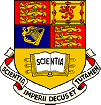
 |
|
News Page |

April 2000 |
This month's news story:Ulysses comet tail crossing |
 Ulysses Encounters the Tail of Comet Hyakutake
Ulysses Encounters the Tail of Comet HyakutakeResearchers in the SPAT group, with a colleague at Queen Mary and Westfield College, have identified an unique crossing of a comet's tail by the Ulysses spacecraft. The team also identified the comet to which the tail belonged, putting it into the record books for the longest ever recorded comet tail.
Geraint Jones and Andre Balogh of the SPAT group, together with Tim Horbury of QMW, report their findings in the April 6 issue of Nature.
The picture on the right is an artist's impression of the Ulysses spacecraft sweeping across the tail of the distant comet (image courtesy of David Hardy and PPARC). The tail crossing occurred on May 1, 1996, when Ulysses was 3.7AU from the Sun. The Imperial College-built magnetometer was one of the instruments that recorded the tail's presence as it swept over the spacecraft. For over three years, the cause of the strange instrument readings had been a mystery. It was only when "draping" signatures were spotted in the magnetometer data that the event was realized to have been a crossing of a comet's tail.
A search was carried out by the team for the source comet. No known comets were near Ulysses at the time, so the search was extended further afield. Comet Hyakutake had given Earth a spectacular display during late March/ early April 1996, and by 1 May, it was at perihelion. Looking at its path, illustrated in the second figure on the right, the team found that it had actually crossed the Sun-Ulysses line around 8 days earlier - exactly at the right time for it to reach Ulysses on May 1, carried by the solar wind.
Ulysses has returned unique data about the internal magnetic structure of a comet's ion tail. Teams working on other Ulysses instruments are also now working on the event, and it is hoped that a full picture of the tail's make-up will emerge as a result.
The most astounding result is the length of the comet's tail, which was at least 3.8AU, putting the Hyakutake tail in the record books as the longest ever comet tail that has been measured.
More details on this story can be found on the SPAT group web pages at http://www.sp.ph.ic.ac.uk/Ulysses/comet/. This story has generated considerable interest from the press and others. Press releases from PPARC, ESA and NASA are avaible on the web, as well as features in both ESA and NASA science news. Media coverage so far has included the BBC News, CNN and Sky and Telescope magazine.
Geraint Jones and Bob Forsyth 10th April 2000
View Last month's news, older news or return to Space and Atmospheric Physics home page